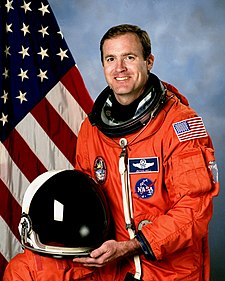James Donald Halsell
| James Donald Halsell | |
|---|---|
 James Donald Halsell | |
| Astronaut NASA | |
| Státní příslušnost | |
| Datum narození | 29. září 1956 (66 let) |
| Místo narození | West Monroe, Louisiana |
| Předchozí zaměstnání | testovací pilot |
| Hodnost | plukovník |
| Čas ve vesmíru | 52 dní, 10 hodin a 34 minut |
| Kosmonaut od | 1990 |
| Mise | STS-65, STS-74, STS-83, STS-94, STS-101 |
| Znaky misí | |
| Kosmonaut do | 2006 |
| Některá data mohou pocházet z datové položky. | |
James Donald Halsell (* 29. září 1956 v West Monroe, stát Louisiana, USA) JE americký letec, důstojník a astronaut. Ve vesmíru byl pětkrát.
Život
Studium a zaměstnání
Absolvoval vojenskou leteckou akademii United States Air Force Academy. Po ukončení studia v roce 1978 pokračoval ve vysokoškolském studiu na Troy State University. Školu ukončil v roce 1983 a pokračoval dalším studiem na USAF Institute of Technology a pilotní škole USAF Test Pilot School na Edwardsově letecké základně. Tu ukončil v roce 1985. Od roku 1979 pracoval u americké armády jako pilot.
V letech 1990 až 2006 byl členem jednotky kosmonautů v NASA v Houstonu. Po ukončení kariéry kosmonauta byl zaměstnán v soukromém sektoru.
Oženil se s Kathy, rozenou Spoonerovou.
Lety do vesmíru
Na oběžnou dráhu se v raketoplánech dostal pětkrát a strávil ve vesmíru 52 dní, 10 hodin a 34 minut. Byl 310 člověkem ve vesmíru.
- STS-65 Columbia (8. července 1994 – 23. července 1994), pilot
- STS-74 Columbia (12. listopadu 1995 – 20. listopadu 1995), pilot
- STS-83 Columbia (4. dubna 1997 – 8. dubna 1997), velitel
- STS-94 Columbia (1. července 1997 – 17. července 1997), velitel
- STS-101 Atlantis (19. květen 2000 – 29. květen) 2000, velitel
Odkazy
Externí odkazy
 Obrázky, zvuky či videa k tématu James Donald Halsell na Wikimedia Commons
Obrázky, zvuky či videa k tématu James Donald Halsell na Wikimedia Commons - Na webu Space
- Na webu MEK-Kosmo
Média použitá na této stránce
STS-94 insignia
The STS-101 mission patch commemorates the third Space Shuttle flight supporting the assembly of the International Space Station (ISS). This flight's primary tasks are to outfit the ISS and extend its lifetime, and to conduct a spacewalk to install external components in preparation for the docking of the Russian Service Module, Zvezda, and the arrival of the first ISS crew. The Space Shuttle is depicted in an orbit configuration prior to docking with the ISS. The ISS is depicted in the stage of assembly completed for the STS-101 mission, which consists of the United States-built Unity module and the Russian-built Zarya module. The three large stars represent the third ISS mission in the assembly sequence. The elements and colors of the border reflect the flags of the nations represented by the STS-101 crew members, the United States and Russia. The NASA insignia design for Shuttle flights is reserved for use by the astronauts and for other official use as the NASA Administrator may authorize. Public availability has been approved only in the form of illustrations by the various news media. When and if there is any change in this policy, which is not anticipated, it will be publicly announced.
Astronaut James D. Halsell, Jr., STS-94 mission commander.
STS-65 Mission Insignia
STS-74 Mission Insignia
- The STS-74 crew patch depicts the orbiter Atlantis docked to the Russian Space Station Mir. The central focus is on the Russian-built docking module, drawn with shading to accentuate its pivotal importance to both STS-74 and the NASA-Mir Program. The rainbow across the horizon represents the Earth's atmosphere, the thin membrane protecting all nations, while the three flags across the bottom show those nations participating in STS-74: Russia, Canada, and the United States. The sunrise is symbolic of the dawn of a new era in NASA space flight , that of International Space Station construction.
The crew patch for NASA's STS-83 mission depicts the Space Shuttle Columbia launching into space for the first Microgravity Sciences Laboratory 1 (MSL-1) mission. MSL-1 investigated materials science, fluid dynamics, biotechnology, and combustion science in the microgravity environment of space, experiments that were conducted in the Spacelab Module in the Space Shuttle Columbia's cargo bay. The center circle symbolizes a free liquid under microgravity conditions representing various fluid and materials science experiments. Symbolic of the combustion experiments is the surrounding starburst of a blue flame burning in space. The 3-lobed shape of the outermost starburst ring traces the dot pattern of a transmission Laue photograph typical of biotechnology experiments. The numerical designation for the mission is shown at bottom center. As a forerunner to missions involving International Space Station (ISS), STS-83 represented the hope that scientific results and knowledge gained during the flight will be applied to solving problems on Earth for the benefit and advancement of humankind.






